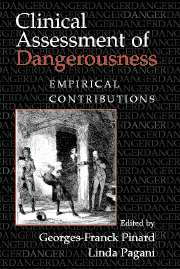Book contents
- Frontmatter
- Contents
- Contributors
- Prologue
- Introduction
- Basic Issues in Violence Research
- 2 Biology, Development, and Dangerousness
- 3 The Development of Physical Aggression During Childhood and the Prediction of Later Dangerousness
- 4 Predicting Adult Official and Self-Reported Violence
- Mental Health Issues and Dangerousness
- Family Issues and Dangerousness
- Individual Characteristics and Dangerousness
- Conclusion
- Index
3 - The Development of Physical Aggression During Childhood and the Prediction of Later Dangerousness
Published online by Cambridge University Press: 03 July 2009
- Frontmatter
- Contents
- Contributors
- Prologue
- Introduction
- Basic Issues in Violence Research
- 2 Biology, Development, and Dangerousness
- 3 The Development of Physical Aggression During Childhood and the Prediction of Later Dangerousness
- 4 Predicting Adult Official and Self-Reported Violence
- Mental Health Issues and Dangerousness
- Family Issues and Dangerousness
- Individual Characteristics and Dangerousness
- Conclusion
- Index
Summary
When Does Violent Behavior Start?
The Adolescent Years
Using data on the prevalence of serious violent crimes from the American National Youth Survey, Elliott (1994) reported that black and white adolescent males and females in the United States became more and more at risk of committing serious violent crimes as they grew older, from 12 to 17 years of age. This sharp increase of violence was then followed, from ages 18 to 27, by an equally dramatic fall in the prevalence of serious violence. Violence appeared to peak at 17 years of age for both black and white adolescents in this national probability sample born between 1959 and 1965. This phenomenon has been labeled the age-crime curve (Farrington, 1987) and appears to have first been published by the Belgian astronomer-statistician-criminologist Adolfe Quetelet in his 1833 book entitled Research on the Propensity for Crime at Different Ages.
The observation that the frequency of criminal activity increases steadily during adolescence, together with the observation of the male female difference in the frequency of criminal behavior, has been used as proof that criminal behavior is strongly influenced by testosterone levels (Ellis & Coontz, 1990; Eysenck & Gudjonsson, 1989; Tremblay & Schaal, 1996). However, the age-crime curve starting during early adolescence also fits the social learning hypothesis that individuals learn to be violent and to commit crimes from their environment (Akers, 1977; Bandura, 1973; Elliott, Huizinga, & Ageton, 1985; Eron, 1990). As children become adolescents they also become physically stronger and sexually mature.
- Type
- Chapter
- Information
- Clinical Assessment of DangerousnessEmpirical Contributions, pp. 47 - 65Publisher: Cambridge University PressPrint publication year: 2000
- 6
- Cited by

